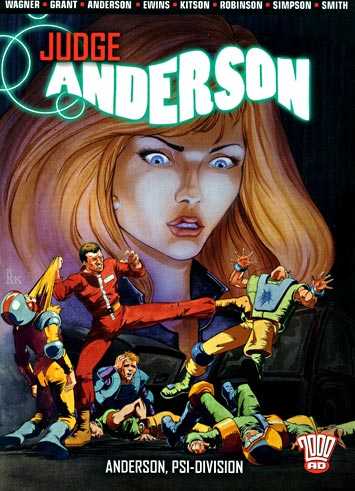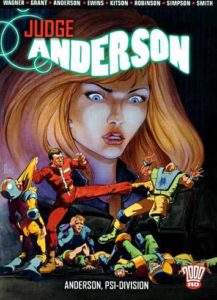Comic Book Review: Judge Anderson: Anderson, Psi-Division written by Alan Grant and John Wagner, art by various.
The Judge Dredd series in 2000 AD has spawned quite a few interesting supporting characters in forty-plus years, several of whom have gone on to their own solo adventures. One of the most popular has been Judge Anderson. Full name Cassandra Anderson, she has psychic powers, including being the strongest telepath on the Judge force of Mega-City One.
She was first introduced in 1980, during the “Judge Death” storyline. Judge Death and his cohorts, the Dark Judges, are from an alternate Earth where it was noticed that all crimes are committed by the living, and therefore life itself was declared a crime. As a Psi-Judge, Anderson was uniquely qualified to help Judge Dredd battle the undead menace, though at the cost of being possessed by Death for some time.
To the extent that Judge Dredd has friends, she’s one of the closest and longest lived, being one of the few people who can call him “Joe.” Judge Anderson is more sarcastic and openly emotional than Dredd, and more willing to admit the faults in the dystopic Judge system, but is also very much an effective and determined Judge.
This volume contains three of her solo stories, originally printed as weekly serials in 2000 AD.
We open with “Four Dark Judges”, a follow-up to the previous Judge Death stories. The last time she’d met Death, Fear, Fire and Mortis, Anderson had destroyed the Dark Judges, supposedly for good. But now Judge Death is on/in her mind, claiming that he is still alive back on Deadworld.
This turns out to be a bluff to trick Anderson into going to Deadworld, where the disembodied spirits of the Dark Judges mind control her into creating new bodies for them. The Dark Judges then proceed to Earth and Mega-City One, where they resume their mass-murdering ways. This time, they have brought along teleportation technology which allows them to retreat before the Mega-City Judges can bring effective weaponry to bear.
Judge Anderson must return to her own world and persuade a dubious Chief Judge to allow her to join the hunt, as only she has an idea of a new way to imprison the Dark Judges securely.
As in other Judge Dredd-related stories, there are moments of dark humor, such as when the Dark Judges attack the Ronald Reagan Block for the Aged. “Dodder for it!” And despite having unleashed horror on the city, Judge Anderson is restored to duty without penalty.
“The Possessed” starts at Ed Poe Block, where innocent child Hammy Blish has been possessed by the demon Gargarax. This proves to be because a black magic cult had summoned it so they could gain ultimate power. The cult is initially unaware they’ve succeeded as they had assumed Gargarax would appear at the gate they opened.
As it turns out, Gargarax actually needs the gate to take Hammy’s possessed body back to its Hell dimension. There, it will be able to use a ritual involving the child’s innocent blood to make the gate permanent, allowing the demons to invade Earth. Judge Anderson is able to follow Gargarax through the gate before it closes, and must battle the demonic hordes alone before they gain their invasion foothold.
This story is helped by having a single artist, Brett Ewins, who creates a hellscape where the scenery and architecture are themselves immobile demons. We learn that the Judges have exorcists on the payroll, though they aren’t much use, and Judge Anderson eventually must make a hard choice.
“Hour of the Wolf” is a return story for Orlock the Assassin, Sov agent who had been responsible for poisoning Mega-City One with the maddening Block Mania to soften it up for the Apocalypse War. (In the Judge Dredd timeline, the Soviet Union never fell as such, but mutated into the Sov-Cities. How Communist they were exactly is unclear.)
A coded telepathic signal involving a giant wolf is sent to several Sov sleeper agents; this is the order to free Orlock from Judge captivity. Judge Anderson is able to pick up the signal, but the Sov agents were aware that she could do so, and their first order of business is to assassinate her before she can figure out what the signal means.
This isn’t a very satisfying story to end the volume on–Judge Anderson spends much of it in a coma, and Orlock gets away in the end. (There would be two sequels involving Anderson’s search for Orlock before he returned to battle Judge Dredd in the main series.)
This volume was the result of a brief joint venture of the 2000 AD company and DC Comics, so there was no second volume; Anderson’s full adventures have been collected elsewhere. Still, worth looking into if you spot it at a garage sale or discount bin.


